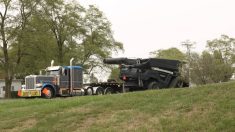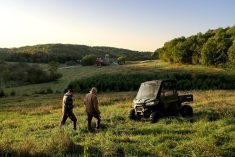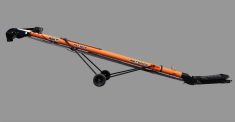A new transmission option and higher top-end horsepower ratings are on the list of improvements to Deere’s biggest MFWD models
50 years ago, in 1963, John Deere introduced its first powershift transmission, bolting it into the now-classic 4020 tractor. At its dealer convention in Columbus, Ohio, the brand celebrated that anniversary by revealing its latest powershift design, the e23, which is now available on the new, five-model line of 7R tractors.
The e23’s 23 forward gears (hence the name) have only a 15 per cent speed difference between them to make for a smooth shift from one to another. The 11 reverse gears have a 30 per cent jump.
“We’re really excited about that e23 transmission,” said Ryan Hough, product marketing manager for tractors. “It takes those 50 years of (powershift) technology and brings it forward.”
Read Also

Claas brings 1000 Series SP forage harvesters to Canada
In mid-August, Claas unveiled its new line of Jaguar forage harvesters at an event in Visalia, California, deep in the heart of that state’s dairy region.
Although it’s still a mechanical transmission, Deere’s marketing reps say it offers the operator a close second in capability and efficiency when compared to an IVT (Infinitely Variable Transmission), while still providing the simplicity and reliability of a powershift. If, however, you really do want an IVT, all 7R models can be ordered with one. The two smallest models, the 7210R and 7310R are also available with the CommandQuad Eco gearbox as well.
To spin those transmissions, all five 7R tractor models get a bump in horsepower. The 6.8- or 9.0-litre PowerTech PSS engines under the hoods, depending which model you look at, now give the 7Rs 210 to 290 engine horsepower.
“We’ve increased the horsepower by 10 across the board,” said Carleton Self, Deere’s product manger for tractors.
With Tier 4 Final emissions regulations coming into force this January for tractors in this horsepower class, Deere has opted to combine a series of systems to get NOx and particulate matter levels down to where they need to be.
An improved, high-pressure, common-rail fuel system and series turbochargers now pack the cylinders with air and fuel. Cooled EGR reduces the amount of NOx created within the cylinders during combustion. Then, as the exhaust makes its way out, a diesel oxidization catalyst and particulate filter — along with the addition of a selective catalytic reduction (SCR) system requiring the use of diesel exhaust fluid (DEF) — scrub out more pollutants.
“When you combine all of those things together and then add SCR, we believe we will have the lowest total fluid consumption of any tractor out there,” said Jerrod McGinnis, division marketing manager. “On the 7R, we anticipate total fluid consumption will decrease about two per cent.”
Although other brands will be offering simpler emissions strategies, Deere believes the combination of treatments it’s chosen allows its PSS engines to operate with the lowest level of diesel and DEF consumption. Marketing reps emphasize it’s important to take consumption of both fluids into account when talking about cost savings.
“We don’t want any of our customers to think all we did was add SCR onto our engines,” said McGinnis. “We’ve done more than that. What we’re trying to do is hit what we call the sweet spot (of lowest diesel and DEF consumption).”
Rather than talk about only fuel efficiency, Deere will be focusing on “total fluid efficiency” in its marketing campaigns.
To keep those Tier 4 Final engines cool, the 7R tractors get a redesigned hood arrangement that is now easier to open, something a few owners criticized about the existing design. The cooling package is also 15 per cent larger, which allows for a slower fan rotation that minimizes the parasitic engine power loss from turning it.
Inside the new CommandView III cab, operators get lower noise levels and a seat that swivels 40 degrees to the right to minimize neck strain when looking behind. The CommandArm gets some improvements as well, with a rearranged control cluster.
A seven-inch 4100, Generation 4, CommandCenter display or optional 10-inch 4600 version are available. And working through the various digital screens becomes more intuitive, with a new layout that makes the screen pages look a lot like those on a smartphone app.
“As we make this equipment more intuitive to use, that allows operators more flexibility in who they’re hiring to operate it,” said Holli Brokaw, AMS product manager. “Deere said we want to meet that ISOBUS standard, but we also want to provide a better user interface.”
The CommandCenter is also compatible with video streaming from remote cameras.
8R tractors
Just like the 7R line, the 8Rs get a jump in horsepower all across the model range, too. For 2014, there will be nine 8R and 8RT tractors with engine horsepower ratings from 245 to 370. The four smaller versions are available with either a 16-speed powershift or IVT transmission. Up from the 8345R, you’ll have to be satisfied with an IVT.
“We’ve increased the engine horsepower ratings of all the new 8R models and boosted the maximum hydraulic flow capacity by 41 per cent to 85 gallons per minute,” said McGinnis. “This 8R option allows customers to operate at reduced engine speed while handling larger implements, such as planters, that require high, constant flow rates.”
The new CommandView III cabs on the 8Rs are available with Active Hydro-Pneumatic Cab Suspension Plus to help smooth out the ride. Inside them you can even opt for a built-in refrigerator.
For night operations, both the 2014 7R and 8R tractors get an optional LED light package that provides 40 per cent more illumination than the HID variety.
“These tractors push productivity and comfort to a higher level to provide greater value to our customers,” said McGinnis. †















